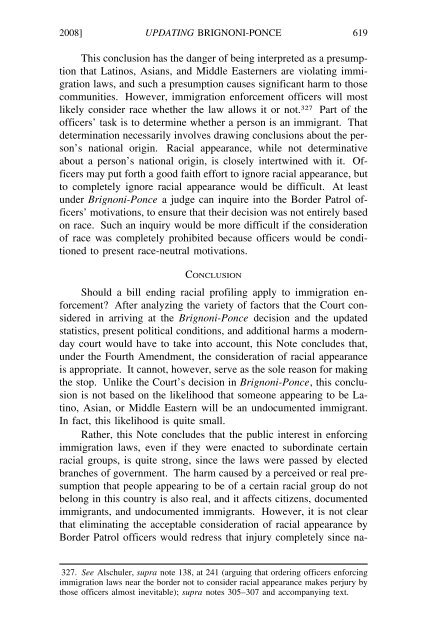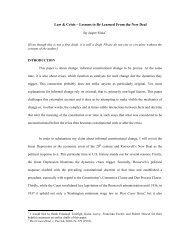updating brignoni-ponce - New York University School of Law
updating brignoni-ponce - New York University School of Law
updating brignoni-ponce - New York University School of Law
Create successful ePaper yourself
Turn your PDF publications into a flip-book with our unique Google optimized e-Paper software.
2008] UPDATING BRIGNONI-PONCE 619<br />
This conclusion has the danger <strong>of</strong> being interpreted as a presumption<br />
that Latinos, Asians, and Middle Easterners are violating immigration<br />
laws, and such a presumption causes significant harm to those<br />
communities. However, immigration enforcement <strong>of</strong>ficers will most<br />
likely consider race whether the law allows it or not. 327 Part <strong>of</strong> the<br />
<strong>of</strong>ficers’ task is to determine whether a person is an immigrant. That<br />
determination necessarily involves drawing conclusions about the person’s<br />
national origin. Racial appearance, while not determinative<br />
about a person’s national origin, is closely intertwined with it. Officers<br />
may put forth a good faith effort to ignore racial appearance, but<br />
to completely ignore racial appearance would be difficult. At least<br />
under Brignoni-Ponce a judge can inquire into the Border Patrol <strong>of</strong>ficers’<br />
motivations, to ensure that their decision was not entirely based<br />
on race. Such an inquiry would be more difficult if the consideration<br />
<strong>of</strong> race was completely prohibited because <strong>of</strong>ficers would be conditioned<br />
to present race-neutral motivations.<br />
CONCLUSION<br />
Should a bill ending racial pr<strong>of</strong>iling apply to immigration enforcement?<br />
After analyzing the variety <strong>of</strong> factors that the Court considered<br />
in arriving at the Brignoni-Ponce decision and the updated<br />
statistics, present political conditions, and additional harms a modernday<br />
court would have to take into account, this Note concludes that,<br />
under the Fourth Amendment, the consideration <strong>of</strong> racial appearance<br />
is appropriate. It cannot, however, serve as the sole reason for making<br />
the stop. Unlike the Court’s decision in Brignoni-Ponce, this conclusion<br />
is not based on the likelihood that someone appearing to be Latino,<br />
Asian, or Middle Eastern will be an undocumented immigrant.<br />
In fact, this likelihood is quite small.<br />
Rather, this Note concludes that the public interest in enforcing<br />
immigration laws, even if they were enacted to subordinate certain<br />
racial groups, is quite strong, since the laws were passed by elected<br />
branches <strong>of</strong> government. The harm caused by a perceived or real presumption<br />
that people appearing to be <strong>of</strong> a certain racial group do not<br />
belong in this country is also real, and it affects citizens, documented<br />
immigrants, and undocumented immigrants. However, it is not clear<br />
that eliminating the acceptable consideration <strong>of</strong> racial appearance by<br />
Border Patrol <strong>of</strong>ficers would redress that injury completely since na-<br />
327. See Alschuler, supra note 138, at 241 (arguing that ordering <strong>of</strong>ficers enforcing R<br />
immigration laws near the border not to consider racial appearance makes perjury by<br />
those <strong>of</strong>ficers almost inevitable); supra notes 305–307 and accompanying text. R
















